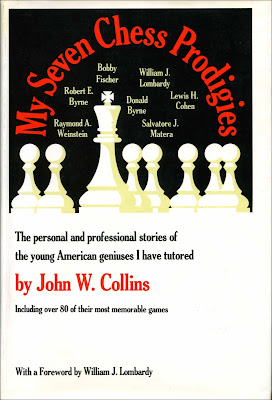 |
| From Bobby Fischer by Harry Benson, New York, 2011 |
Bobby Fischer was renowned for his knowledge of chess literature and, not only studied the games and writings of his contemporaries, but was a very keen student of all of his great predecessors and of chess literature from the 19th century onwards.
From June 1956 to July 1958 Bobby Fischer spent much of his time at the home of John W. Collins where the Hawthorn Chess Club met several times a week. In Collins' book My Seven Chess Prodigies, New York, 1974, he recalls Fischer's voracious appetite for chess literature.
Frank Brady wrote the first, and probably still the best, biography of Fischer in his 1965 book Profile of a Prodigy: The Life and Games of Bobby Fischer, and a new enlarged edition was published in 1973 following the World's Championship match.


Frank Brady relates the following on page 8 of the 1965 first edition:
Brady expanded on this in the New Edition of 1973 and mentioned many of the books in Fischer's library in 1972 on pages 11 and 12:
Dimitrije Bjelica relates on page 67 of his Grandmasters in Profile that, in 1967, Fischer requested some old chess books from Lothar Schmid:
Fischer had a high regard for many 19th century chess players and writers and included five in his famous article The Ten Greatest Masters in History on pages 56-61 of Chessworld Volume I Number 1, January-February 1964, these being Staunton, Morphy, Tchigorin, Steinitz and Tarrasch.




Such was Fischer's knowledge and recall of chess literature that he frequently cited chapter and verse in his own writings and game annotations. Some examples of Fischer's references to 19th century chess literature follow:
A Bust to the King's Gambit, on pages 3-9 of The American Chess Quarterly volume one number one, Summer 1961, starts with a reference to The Chess Player's Manual by G.H.D.Gossip and S.Lipschütz, (originally published in 1875, not 1874 as stated by Fischer although the Preface is dated 1874, with Lipshütz coming on board for the revised edition of 1888).
There is an interesting follow up to this article in ACQ vol.2 no.3 Winter 1962-1963, pages 486-487, where Fred Wren quotes a letter from Wendell John Lutes who pointed out that Fischer's analysis had been included in Labourdonnais' Le Palamède, almost word for word.
Another extract from ACQ vol. 3 no. 4, Spring 1964:
Fischer's excellent annotations in his My 60 Memorable Games include many 19th century references including the following:
Fischer's excellent annotations in his My 60 Memorable Games include many 19th century references including the following:
Game 18, note to white's sixth move; `Morphy-Anderssen, Paris 1858´
Game 34, note to black's third move; `played by Charousek in the 'nineties´
Game 44, note to black's ninth move; `The best defense follows an old analysis from Freeborough and Rankin (1893)´




Game 45, There are several references to Steinitz and Tchigorin and in the note to black's tenth move, Fischer cites Dr. Gottschall in the 1892 Deutsche Schachzeitung.
Game 51, note to black's fifth move; `Anderssen-Morphy, match 1858!´
Game 56, notes to black's 5th move; references to Schallopp-Harmonist and Schallopp-Blackburne, Frankfurt, 1887.
Steinitz in particular receives many mentions throughout the book.
However, the earliest work referred to by Fischer, that I have found, albeit in a second hand account, is A Treatise on The Game of Chess by J.H.Sarratt published in London, 1808.
Chess volume 66, June 2001 page 21 has an article entitled Encounter with Bobby Fischer in which the author, Anthony Mantia, recalls his meeting with Fischer at a simultaneous event in 1964 and includes the following quote by Fischer: `That line was refuted in 1808 as published in Sarratt's treatise.´
Chess volume 66, June 2001 page 21 has an article entitled Encounter with Bobby Fischer in which the author, Anthony Mantia, recalls his meeting with Fischer at a simultaneous event in 1964 and includes the following quote by Fischer: `That line was refuted in 1808 as published in Sarratt's treatise.´
© Michael Clapham 2016















No comments:
Post a Comment